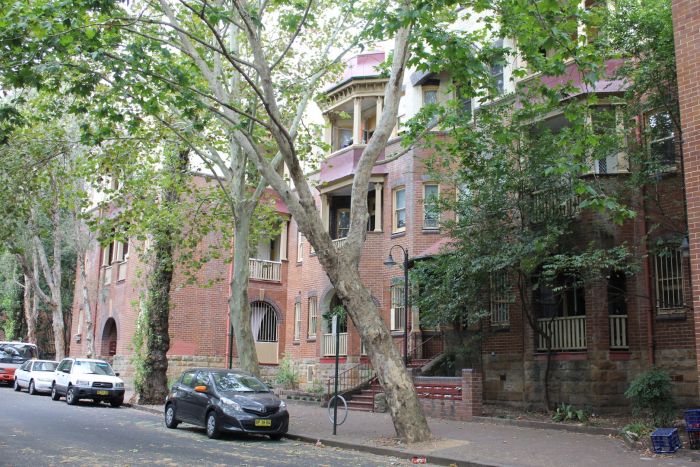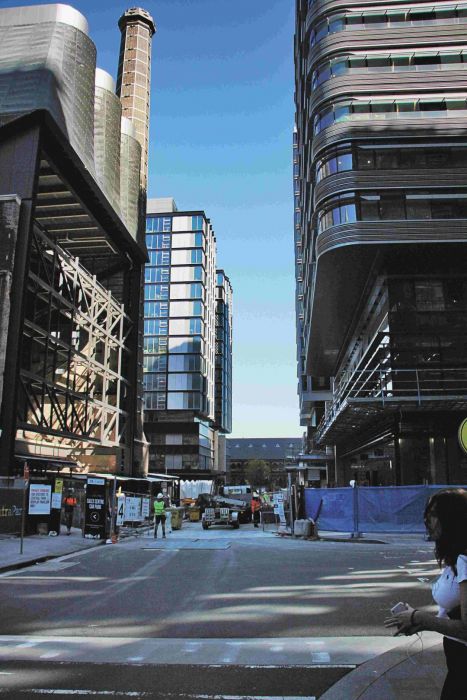Ms Fitzgerald says she’d still call it unpretentious: “It’s got the trendy eating places and so on, but I still don’t think in the minds of Sydneysiders it’s got a particularly high profile as a place to live.”
It certainly didn’t have a high profile in 1819, when new arrival William Chippendale and his family were granted a parcel of bushland on what was then the very edge of town. Chippendale’s boundaries extended east to Chalmers Street and in part as far south as what is now Henderson Road, Alexandria.
Today Chippendale is officially bordered by the railway line, Broadway, City Road and Cleveland Street. However, what to call the southern side of Cleveland Street remains a point of discussion for the locals.
“When we first moved into the area [in] the early 1970s, it was called Chippendale, and then it became Darlington,” says architect Jocelyn Jackson, who has lived on both sides of Cleveland Street. “They started to rename all the suburbs as they were originally, because it was originally Darlington.” The suburb of Darlington, however, still contained the Chippendale old post office and, later, the Chip’n’Dale takeaway shop.
Chippendale’s character has undergone several transformations.

Sydney’s first public housing, Strickland House, was built in Chippendale in 1914 and is still home to public housing tenants.
For early residents, Chippendale was synonymous with Tooth’s Beer, White Wings cakes and MacRobertson’s chocolate factory. Larger-than-life distiller Robert Cooper “gave the place a stamp and he gave it a smell,” Shirley Fitzgerald says. “Chippendale really is about smells. It was the brewery for years and years and years, and the hops and the stench of that … People used to talk about the wonderful aromas of the White Wings cake factory, that would have the vanilla days and chocolate days.”
In 1961, 33.5 per cent of Chippendale residents worked in manufacturing. By 1986 that had fallen to 8.8 per cent, and the population had shrunk from 2,458 to 1,537 in the same period.
“In 1978 when I bought my property, it was one of Sydney’s most dangerous suburbs,” says Michael Mobbs, whose off-grid house and kerbside community garden in Myrtle Street inspired his book Sustainable House and has made him one of Chippendale’s best-known residents. “The agent said to me: ‘Mr Mobbs, why do you want to live in Chippendale? Only criminals and prostitutes live in Chippendale.’”
The suburb lived up to this reputation in 1981 when notorious corrupt police officer Roger Rogerson shot and killed a heroin dealer in suspicious circumstances in the aptly named Dangar Place. The incident would later be dramatised for an ABC miniseries. The site of the shooting is still marked by an “X” scratched into the gutter.
“Stray dogs, stray cats – it was very much an unloved suburb,” says Jocelyn Jackson.
“Chippendale was pretty much a latecomer to being accepted as a trendy place to live,” Shirley Fitzgerald agrees.
Ms Fitzgerald acknowledges that the suburb has undergone huge changes even in the three decades since she wrote her book.
The 2016 census recorded 8,617 people living in Chippendale, 71.4 per cent of whom rent. Almost half – 46.5 per cent – of Chippendale’s residents are under housing stress, that is, they spend 30 per cent or more of their income on rent. The proximity of three universities – the University of Sydney, Notre Dame and UTS – has seen an influx of students and high-density student housing.
Another reason for Chippendale’s newfound desirability is the abundance of street trees, particularly in the western half of the suburb. Chippendale’s current incarnation as a trendy, built-up metropolis belies its history as a fertile farm – where Buckland Street now runs was once a creek that fed into Blackwattle Bay. Ms Fitzgerald says that, when she was researching the suburb for her book, “the real revelation was to discover the truth of the wonderful soil that exists there”.
There was “absolutely not a tree in sight” when Jocelyn Jackson moved in, she says. “The greenies that we were … planted out trees in the ’70s and now we’ve got these 40-, 50-metre gum trees that we wish we hadn’t planted.”
Michael Mobbs says Chippendale is a unique sanctuary from the hubbub of the city: “The suburb is surrounded by four rivers of steel, possibly the busiest roads in Australia, but you hear none of it [from my place], because the old warehouses and buildings reflect the noise … so there’s this sense of peace right in the heart of the city.”

Today, Chippendale is a place of increased tension between old and new. Down the road from Strickland House, the latest building in the mammoth Central Park development is almost complete. More and more of Chippendale’s buildings are being bought and redeveloped by the three surrounding universities. Chippendale Green has drawn the ire of long-term residents for attracting groups of partying youth.
“I think the population has become very skewed in terms of the demographic,” says art dealer Michelle Perry, who has lived in Chippendale for 23 years. “Where we used to have a mixture of families and elderly and students, now we’ve just got thousands of students.”
Ms Perry says that Chippendale’s well-known arts scene is also becoming more commercialised. “Originally it was a very organic arts scene, it was actually artists making artwork there, and now … they have slick arty businesses. Having said that, we’ve got White Rabbit, which is fantastic.”
Michael Mobbs is getting ready to leave Chippendale and the sustainable house which has been his home for 40 years. “They say that moving is worse than divorce – I’m here to tell you that’s true.”
The suburb is transforming again, and the young, the old, the artists and the developers are competing to define the next chapter in Chippendale’s history.





